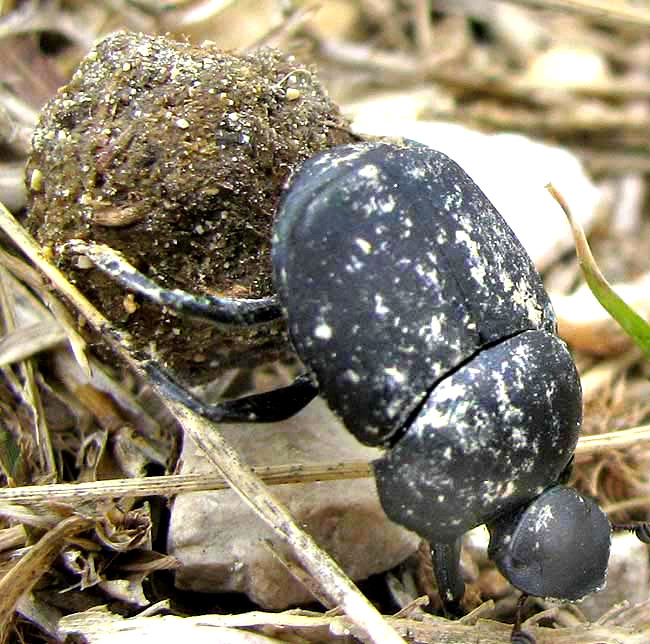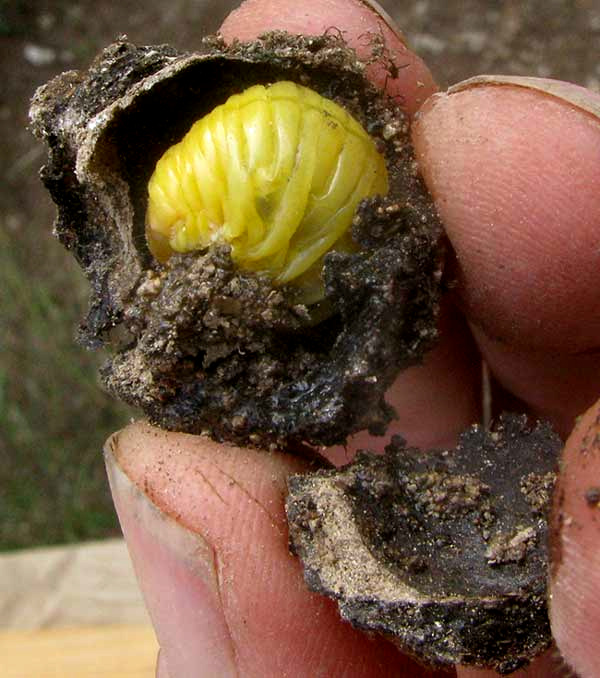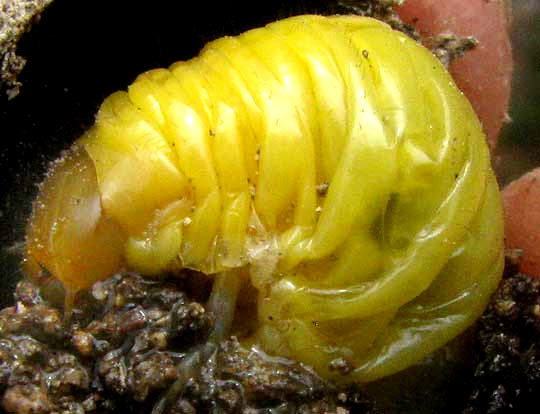Excerpts from Jim Conrad's
Naturalist Newsletter

from the September 23, 2012 Newsletter issued from the valley of the Dry Frio River in northern Uvalde County, southwestern Texas, on the southern border of the Edwards Plateau; elevation ~1750m (~5750 ft); N29.62°, W99.86°; USA
TUMBLEBUGS
Last weekend my neighbor plowed his pasture next to the cabin where I live, and that resulted in large numbers of tumblebugs rolling balls of manure across our little gravel road.
Tumblebugs are also called dung beetles, and there are many species of them spread through several genera in the subfamily Scarabaeinae, which alone comprises more than 5000 species. Tumblebugs are a subgroup of scarab beetle. In the above picture the mottling on the beetle's body is dried poop.
Not all dung beetles roll balls of manure. Some species live in tunnels dug beneath piles of poop, and are called tunnelers. Others simply live in the poop, and are called dwellers. Our ball rollers are rollers.
"Rollers" roll and bury a dung ball either for food or for laying eggs in them. During the rolling process other rollers may try to steal the ball, so that explains why all the rollers seen last weekend seemed to be in a hurry. In some species the male and female roll the ball together, while in others the male does most of the rolling, with the female sometimes hitching a ride. The balls I saw being rolled were mostly moved by one beetle. When a spot with soft soil is found the ball is buried. Then the male and female mate underground, and the female lays eggs inside the ball. In some species the beetles remain in the tunnel guarding their offspring
At least in this part of the world tumblebugs are not just unusual oddities; they do important work and people in the know regard them as desirable, beneficial insects. In parts of Texas studies show that dung beetles remove 80 percent of a grazing area's cattle droppings, and that goes a long way in keeping down the numbers of disease-transmitting flies.
Why did my neighbor's plowing cause such a frenzy of ball rolling? Maybe the turned-up soil was easier for the rollers to roll their balls through than the previous forests of grass stems, or maybe the balls had been buried, and now the beetles were transferring their prizes to less disturbed fields. Whatever the case, it was hilarious seeing so many little balls of poop being tumbled across the gravel road.
from the September 22, 2013 Newsletter issued from the valley of the Dry Frio River in northern Uvalde County, southwestern Texas, on the southern border of the Edwards Plateau; elevation ~1750m (~5750 ft); N29.62°, W99.86°; USA
GRUB IN A DIRTBALL
While digging out a level area for our new greenhouse I unearthed a ball of dark brown dirt looking like a chocolate bonbon. One side was falling away revealing something yellow and shiny inside so I picked it up, the side came loose, and I saw what's shown below:

It was a grub-type insect larva, shown close-up below.

The grub seems to have been disturbed during its early stages of metamorphosing from a grub to a pupa, which then will metamorphose into an adult insect -- presumably a beetle because the grub is shaped and sized more or less like the grub of a June Bug or Japanese Beetle. The grub's skin appears loose and is developing strange folds, maybe something needing to happen for the metamorphosis.
Grubs I've run into before were white, so I thought this yellow one might be easy to identify. However, neither volunteer identifier Bea in Ontario nor I have been able to find anything exactly like it on the Internet.
I'm guessing that this is a dung beetle grub, since the dirtball more or less looks like the balls of dung our abundant dung beetles are likely to be seen pushing around -- cow dung in the valley, deer dung here on the hill.
Beetles undergo complete metamorphosis. The dung beetle's egg is inserted into a ball of dung, a grub-type larva hatches and eats the dung the ball is made from, hollowing it out, and when the grub grows to a certain size it metamorphoses into a pupa, a strange-looking resting stage more similar to a grub than a beetle, and eventually the pupa metamorphoses into a dung beetle. The beetle exits the ball of dung, flies away, finds dung and a dung beetle of the opposite sex, and reproduces.
from the August 7, 2005 Newsletter issued from the Sierra Nevada Foothills east of Sacramento, California, USA
TUMBLEBUG
Finishing my morning crap, even before I'd pulled my breeches up, one of my little turds moved. I was astonished.
It hadn't been on the ground more than three minutes and nothing was visible at its sides so obviously something was moving it from below. That turd was bouncing around exactly as if a tumblebug were beneath it, but surely no tumblebug would be at work after less than three minutes.
However, it was indeed a tumblebug, a species smaller than the big, greenish ones I've seen in the Southeast. Tumblebugs, also called Dung Beetles, belong to the Scarab Beetle Family, a huge family (±1300 North American species) famous for the brilliant, often metallic colors of some of its species.
I've never beheld a more fastidious bug. For several minutes he probed and nudged two of my smaller creations before settling on a much larger blob, beneath which he vanished entirely.
Of course the thing that dung beetles do is that a pair of them will form a mass of dung into a ball, roll the ball a distance, dig a hole, and bury it. Then the female lays her eggs in it. When the eggs hatch, the larvae find themselves in the very satisfying position of being entirely surrounded by their favorite sustenance.
I had to leave before my little beetle did all that. However, judging from the zeal with which he'd begun his job, I'll bet that by the time you read this some little dung-beetle larvae will be feeling very snug indeed, thanks to me.